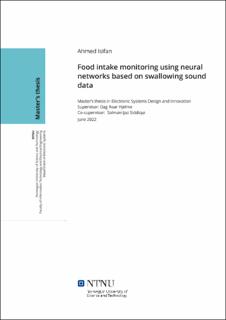| dc.contributor.advisor | Hjelme, Dag Roar | |
| dc.contributor.advisor | Siddiqui, Salman Ijaz | |
| dc.contributor.author | Isifan, Ahmed | |
| dc.date.accessioned | 2022-09-28T17:42:41Z | |
| dc.date.available | 2022-09-28T17:42:41Z | |
| dc.date.issued | 2022 | |
| dc.identifier | no.ntnu:inspera:104140281:37538680 | |
| dc.identifier.uri | https://hdl.handle.net/11250/3022386 | |
| dc.description.abstract | Kunstig Bukspyttkjertel systemer er avhengige av Kontinuerlig Glukose Overvåkningssystemer
til å måle blodsukkernivået, og basert på denne målingen beregnes
insulindosen og avgis via en insulinpumpe. Disse systemer er derimot ikke
perfekte og lider av tidsforsinkelser fra starten på måltidet er oppdaget frem
til insulin er administrert. Pasienter er påkrevd å kunngjøre måltids inntaket i
tillegg til å kalibrere systemet på daglig basis. I et tidligere prosjekt ble arbeidet
utført av Konstanze K. om automatisk deteksjon på starten av måltidet ved bruk
av tarm lydopptak videreført, og svelge lydopptak ble innført. Dette prosjektet
viderefører det arbeidet og tilpasser det slik at kun lydopptak av svelgelyder
benyttes. I tillegg, ble en tale, måltidsstart, mattype, og svelge detektor bygget
for å overvåke matinntaket, dette inkluderer varigheten på måltidet, mattype,
og antall svelger. Dette studiet har visst potensialet av å bruke svelge lydopptak
til å forbedre og unngå ulempene med en kunstig Bukspyttkjertel.
På første delen av prosjektet ble 10 svelge lydopptak brukt til å bygge en
måltidsstart og en tale detektor. Ved å bruke disse opptakene ble effektspektraltetthet
features beregnet, og brukt til å trene og bygge en Multilayer Perceptron
klassifiseringsmodell. Tale detektoren hadde en nøyaktighet og en F1 score på
99%, mens måltidsstart detektoren hadde en nøyaktighet og en F1 score på
95%.
På den andre delen av prosjektet, ble 20 nye opptak tatt for å bygge en mattype
og en svelge detektor. Disse opptakene ble hentet ved hjelp av to forhåndsvalgte
mattyper, havre og salat. Opptakene ble samlet ved hjelp av to personer, hvor
hvert opptak varte i ca. 30 min til 35 min, og mikrofonene som ble benyttet
for å fange svelgelydene ble plassert rett over kragebeinet på halsen. Ved å
bruke disse opptakene, ble Mel spektrogram features beregnet og brukt til å
lage en Convolutional Neural Network klassifiseringsmodel. Svelge detektoren
hadde en nøyaktighet på 93% og en F1 score på 92%, imens mattype detektoren
hadde en nøyaktighet og en F1 score på 96%. | |
| dc.description.abstract | Artificial Pancreas systems rely on Continuous Glucose Monitoring systems to
measure blood glucose levels and based on that measurement, the insulin dose
is calculated and administered through an insulin pump. However, these systems
are not perfect and suffer from time delays from the onset of the meal
until the meal is detected and insulin is administered. Patients are required
to announce their meal intake and also calibrate the system by taking a finger
stick blood test on a daily basis. In a previous project, the work done by
Konstanze k. on automatic meal onset detection using bowel sound recordings
was continued, and swallowing sound recordings were introduced. This project
continues the previous work and adapts such a system using only swallowing
sound recordings. Furthermore, speech, meal onset, meal type, and swallowing
detectors were built to monitor the food intake, this includes the duration of
the meal, the meal type, and the number of swallows. This study showed the
potential of using swallowing sound recordings to improve and work around
the downsides of Artificial Pancreas systems.
For the first part of the project, 10 swallowing recordings were used to build
a meal onset and a speech detector. Using these recordings, Power Spectral
Density features were extracted and used for training and building Multilayer
Perceptron classification models. The speech detector had an accuracy and an
F1 score of 99%, while the meal onset detector had an accuracy and an F1 score
of 95%.
For the second part of the project, 20 new recordings were acquired to build
a meal type and a swallowing detector. These recordings were acquired using
two pre-selected meals, oats and salad. The recordings were obtained using
two subjects, where each recording was about 30 min to 35 min, and the microphone
used for capturing the swallowing sounds was placed just above the
collar bone on the neck. Using these recordings, Mel spectrogram features were
extracted and used to build Convolutional Neural Network classification models.
The swallowing detector had an accuracy of 93% and an F1 score of 92%,
while the meal type detector had an accuracy and an F1 score of 96%. | |
| dc.language | eng | |
| dc.publisher | NTNU | |
| dc.title | Food intake monitoring using neural networks based on swallowing sound data | |
| dc.type | Master thesis | |
